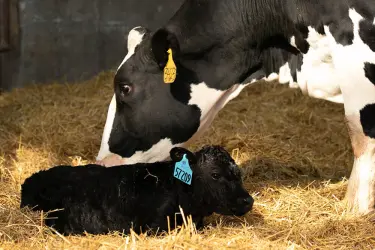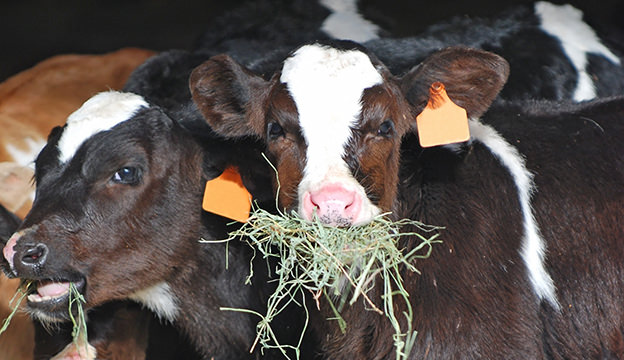Explore the impact of advanced implant and breeding strategies on beef-dairy cross calf performance. Is your cattle management approach as effective as it could be?

The rise of beef-dairy hybrid animals in the American cattle market presents a unique opportunity for dairy producers to optimize their herds. Supported by the Iowa Beef Industry Council and Iowa Beef Checkoff, Iowa State University researchers conducted a pivotal survey to understand better the management techniques and challenges these farmers face.
This comprehensive survey targeted both dairy producers and commercial feedlot operators to:
- Learn about dairy producers’ and calf ranches’ management practices for beef-cross calves.
- Understand the finishing challenges of beef-cross calves from commercial feedlot operators’ perspectives.
The study’s results highlight the potential benefits of improved implant and breeding techniques for beef-dairy crossbred calves. Critical stakeholders in the U.S. cattle sector: Using these techniques could significantly increase the profitability and production of these hybrid animals, offering a promising future for the industry.
Unveiling the Path to Improved Beef-Cross Calf Management and Feedlot Success
This mission unites us, and we are all dedicated to achieving it. Your participation and support are crucial in this collective effort. The poll aimed at two main objectives. First, it grasped the management techniques of specialist calf ranches producing beef-cross calves and dairy farmers. This sought to underline effective strategies and development opportunities, encouraging improved calf output and trust in your operations. Second, it pinpointed particular difficulties commercial feedlot managers have in completing beef-cross calves. This examined growth performance, health concerns, and carcass quality to increase feedlot efficiency and product quality, thus offering trust and assurance in your product.
Insights from 11 Prolific Calf Raisers: Emphasizing Early-Life Nutrition and Identifying Gaps in Health Protocols
Eleven farmers producing more than 21,000 dairy or beef-cross calves annually shared their calf-rearing techniques. The majority emphasized the crucial role of early nutrition and health management, demonstrating a solid understanding of colostrum feeding and regular screening for passive immunity. However, one producer who purchased calves from auctions lacked verified colostrum status, indicating potential health procedure flaws.
Overcoming Multifaceted Challenges in Calf Rearing: Innovative Solutions for Enhanced Welfare and Productivity
Many problems in calf raising call for creative ideas to improve the welfare and output of beef-cross calves. Key aspects, including lowering liver abscesses, improving sire genetics, and besting diet strategies, have drawn attention from producers. Dealing with liver abscesses calls for improved dietary changes and health maintenance routines. Enhancing sire genetics guarantees calves have robust features suited for development and health, ensuring more effective and lucrative rearing.
It is vital to start preventing disease. Especially within the first 30 days, early treatments and optimal feeding plans may strengthen immune responses and lower early-life morbidity and death. Studies on weather effects and stress avoidance can also improve calf well-being.
Finally, improving carcass cutout quality depends on improving market value and providing good raising techniques. These realizations give the path to overcome the urgent problems in calf raising, thus promoting sustainability and progress in beef-cross calf management.
Disparity in Entry Weights: Highlighting the Need for Specialized Early-Life Management for Beef-Cross Calves
Answers from the twenty-one cattle feeders indicated a clear difference in entrance weights between beef and beef-cross calves. This disparity emphasizes the importance of specific early-life care and dietary plans for calves from beef crosses, underlining our proactive role in ensuring their well-being and development.
Beef-cross calves had better carcass performance even if their weight was less. Comparing 13% of beef-cross animals rated Prime to a 7.54% industry average, feeders said that in addition to the national average of 6.77%, 22% of beef-cross calves attained Yield Grade 1. These numbers highlight the tremendous genetic potential of beef-cross calves and stress the necessity of improved breeding and feedlot practices.
Refining Implant Strategies: The Need for Customization to Enhance BXD Calf Performance and Economic Viability
The ISU researchers found notable differences by analyzing the many implant techniques for beef-cross calves. They underlined the requirement for a customized strategy specifically for beef-dairy crossbred (BXD) calves, which differs from conventional approaches for purebred beef cattle. BXD calves have unique characteristics, including variations in days on feed, marbling genetics, and muscular growth.
An ideal implant technique for BXD calves should consider these genetic and physiological variations to improve development and carcass quality. The researchers contended that the present one-size-fits-all approach would impair BXD calf performance by failing to meet their particular demands. Optimizing these techniques might increase producers’ economic returns and efficiency, thereby stressing the need for further studies in this field.
Advanced Education in Beef Semen Selection: Balancing Feedlot Performance and Calving Ease for Optimal Beef-Cross Calf Outcomes
Emphasizing the significance of selecting sires that improve feedlot performance and carcass quality without compromising calving ease, feeders underlined the need for increased education on beef semen selection. One must balance ease of calving with solid development. Producers can guarantee that beef-cross calves attain their maximum potential by concentrating on genetic markers affecting marbling and muscle properties, producing more excellent production and quality grades.
ISU scientists underlined the need for further investigation to find the perfect beef bulls. While keeping reasonable calving criteria, this study should optimize performance and development. Working with geneticists and industry professionals will enable the development of a sensible semen selection process that satisfies these objectives, promoting a more successful beef-dairy crossbreeding system.
The Bottom Line
With beef-dairy crossbred animals exhibiting great success, an experimental project has become a pillar of the U.S. cattle business. Iowa State University’s poll underlined the necessity of improved colostrum techniques, resolution of liver abscesses, and improvement of dietary guidelines. Different implant techniques and entrance weights point to the requirement for customized treatment plans. Crucial new information highlights the better carcass performance of beef-cross calves, therefore stressing the need for targeted breeding techniques and feedlot performance. Industry players may use this research as a road map to increase beef-cross calf welfare and output. Dairy producers should use these realizations to increase profitability and assist environmentally friendly farming. Keep ahead of the competitive scene of beef-cross calf farming.
For comprehensive details, access the study’s complete report here.
Key Takeaways:
- The majority of calf raisers are well-versed in colostrum feeding and passive immunity transfer, yet gaps remain with calves sourced from auctions.
- Critical areas for further research include liver abscess reduction, genetic selection, sickness prevention in early life, and nutrition planning.
- Significant disparities exist in the entry weights of beef and beef-cross calves entering feedlots, suggesting a need for specialized early-life management strategies for beef-cross calves.
- Beef-cross calves exhibit superior carcass performance, with higher percentages grading Prime and producing Yield Grade 1 compared to industry averages.
- Variation in implant strategies indicates a necessity for tailored protocols for beef-cross calves to optimize feedlot outcomes.
- Feeders express a strong need for advanced education in selecting appropriate beef sires that enhance feedlot performance and ensure high-quality carcass finish without compromising calving ease.
Summary:
A survey conducted by Iowa State University aimed to understand the management techniques and challenges faced by dairy producers and commercial feedlot operators in the American cattle market. The study focused on beef-dairy hybrid animals, focusing on growth performance, health concerns, and carcass quality. The survey found that eleven farmers producing over 21,000 dairy or beef-cross calves annually shared their calf-rearing techniques, emphasizing the importance of early nutrition and health management. However, one producer who purchased calves from auctions lacked verified colostrum status, indicating potential health procedure flaws. Key aspects to improve the welfare and output of beef-cross calves include lowering liver abscesses, improving sire genetics, and besting diet strategies. Early treatments and optimal feeding plans can strengthen immune responses and lower early-life morbidity and death. Improving carcass cutout quality depends on improving market value and providing good raising techniques. The research highlights the need for improved colostrum techniques, resolution of liver abscesses, and improved dietary guidelines.
 Download “The Ultimate Dairy Breeders Guide to Beef on Dairy Integration” Now!
Download “The Ultimate Dairy Breeders Guide to Beef on Dairy Integration” Now!
Are you eager to discover the benefits of integrating beef genetics into your dairy herd? “The Ultimate Dairy Breeders Guide to Beef on Dairy Integration” is your key to enhancing productivity and profitability. This guide is explicitly designed for progressive dairy breeders, from choosing the best beef breeds for dairy integration to advanced genetic selection tips. Get practical management practices to elevate your breeding program. Understand the use of proven beef sires, from selection to offspring performance. Gain actionable insights through expert advice and real-world case studies. Learn about marketing, financial planning, and market assessment to maximize profitability. Dive into the world of beef-on-dairy integration. Leverage the latest genetic tools and technologies to enhance your livestock quality. By the end of this guide, you’ll make informed decisions, boost farm efficiency, and effectively diversify your business. Embark on this journey with us and unlock the full potential of your dairy herd with beef-on-dairy integration. Get Started!













